

Fracking hell: what it's really like to live next to a shale gas well. Link to video: Fracking in Ponder, Texas: the real cost Veronica Kronvall can, even now, remember how excited she felt about buying her house in 2007.

It was the first home she had ever owned and, to celebrate, her aunt fitted out the kitchen in Kronvall's favourite colour, purple: everything from microwave to mixing bowls. A cousin took pictures of her lying on the floor of the room that would become her bedroom. She planted roses and told herself she would learn how to garden. Methane leaks erode green credentials of natural gas. David Zalubowski/AP Photo Natural-gas wells such as this one in Colorado are increasingly important to the US energy supply.
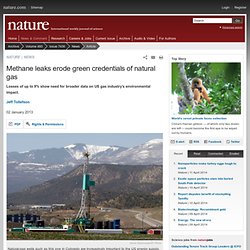
Scientists are once again reporting alarmingly high methane emissions from an oil and gas field, underscoring questions about the environmental benefits of the boom in natural-gas production that is transforming the US energy system. The researchers, who hold joint appointments with the National Oceanic and Atmospheric Administration (NOAA) and the University of Colorado in Boulder, first sparked concern in February 2012 with a study1 suggesting that up to 4% of the methane produced at a field near Denver was escaping into the atmosphere. How Has Fracking Changed Our Future? – The Great Energy Challenge Blog. Has fracking changed our energy future for the better, or for the worse?

Read viewpoints on both sides and vote in the poll below. The use of hydraulic fracturing to extract oil and gas from the earth dates back to the 1940s, but only in the past few years has “fracking” become an energy buzzword, alluding primarily to the shale gas boom in the United States and all of the controversy that has accompanied it. Fracking—the high-pressure injection of water, chemicals and sand into shale deposits to release the gas and oil trapped within the rock—in recent years has been combined with horizontal drilling and other improvements in technology to harvest stores of gas and oil that previously were thought commercially unfeasible to access.
(See interactive: “Breaking Fuel from the Rock“) The implications of this sea change are debatable, but the impact is undeniable. Positive impacts of fracking “Natural gas is not a permanent solution to ending our addiction imported oil. “My town was dying. Review & Outlook: The Facts About Fracking. S Study of Hydraulic Fracturing and Its Potential Impact on Drinking Water Resources. At the request of Congress, EPA is conducting a study to better understand any potential impacts of hydraulic fracturing on drinking water resources.

The scope of the research includes the full lifespan of water in hydraulic fracturing. The progress report was released in December 2012 and a draft report is expected to be released for public comment and peer review in 2014. The Shale Boom Economy Is Overrated. Fracking in the UK: Will fracking lower bills? Shale gas won't stop peak oil, but could create an economic crisis. A new report out last week from the US Energy Information Administration (EIA) has doubled estimates of "technically recoverable" oil and gas resources available globally.
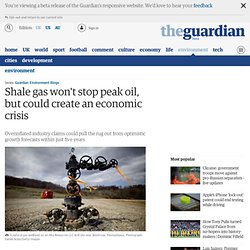
The report says that shale-based resources potentially increase the world's total oil supplies by 11 per cent. Acknowledging fault-lines in its new study, contracted to energy consulting firm Advanced Resources International Inc. (ARI), the EIA said: Fracking: It's the economics stupid. US fracking sites impact health - report. Introduction — The Endocrine Disruption Exchange. As natural gas production rapidly increases across the U.S., its associated pollutionhas reached the stage where it is contaminating essential life support systems — water, air, and soil — and causing harm to the health of humans, wildlife, domestic animals, and vegetation.
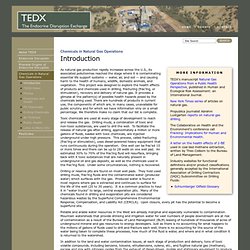
This project was designed to explore the health effects of products and chemicals used in drilling, fracturing (frac’ing, or stimulation), recovery and delivery of natural gas. It provides a glimpse at the pattern(s) of possible health hazards posed by the chemicals being used. There are hundreds of products in current use, the components of which are, in many cases, unavailable for public scrutiny and for which we have information only on a small percentage. We therefore make no claim that our list is complete. Toxic chemicals are used at every stage of development to reach and release the gas. Drilling or reserve pits are found on most well pads. Shale gas extraction emissions are a ‘low’ risk to public health - Press releases. Gas drilling taints groundwater. Les Stone/Reuters/Corbis Shale-gas extraction has transformed the US energy landscape, but its environmental effects are unclear.

As shale-gas operations expand across the United States, industry officials and environmentalists are at loggerheads over whether or not shale-gas extraction can contaminate groundwater. Now researchers have traced low levels of methane and other contaminants to a source of shale gas: the sprawling Marcellus Formation, which lies beneath much of New York state, Pennsylvania, West Virginia and Ohio (see ‘On tap’) .
The study, led by researchers at Duke University in Durham, North Carolina, expands on an earlier analysis of drinking water in northeastern Pennsylvania, where energy companies have used hydraulic fracturing (fracking) to crack the Marcellus Formation and release gas. Hydraulicfractures. Sewage Plants Struggle To Treat Wastewater Produced By Fracking Operations. [+]Enlarge Treated wastewater flows out of a sewage plant in Pennsylvania.
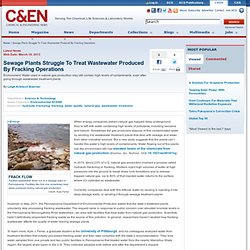
Facilities like this one sometimes treat water produced during natural gas production. Credit: Kyle Ferrar When energy companies extract natural gas trapped deep underground, they’re left with water containing high levels of pollutants, including benzene and barium. Sometimes the gas producers dispose of this contaminated water by sending it to wastewater treatment plants that deal with sewage and water from other industrial sources. In 2010, about 23% of U.S. natural gas production involved a process called hydraulic fracturing or fracking. Currently, companies deal with this leftover water by reusing it, injecting it into deep storage wells, or sending it through sewage treatment plants.
However, in May, 2011, the Pennsylvania Department of Environmental Protection asked that the state’s treatment plants voluntarily stop processing fracking wastewater. To learn more, Kyle J. Regulation Lax as Gas Wells’ Tainted Water Hits Rivers. British Geological Survey’s shale gas groundwater study to omit Cuadrilla’s fracking sites. Potential scenarios of methane pollution from shale.
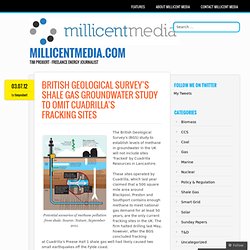
Source: Nature, September 2011. The British Geological Survey’s (BGS) study to establish levels of methane in groundwater in the UK will not include sites ‘fracked’ by Cuadrilla Resources in Lancashire. These sites operated by Cuadrilla, which last year claimed that a 500 square mile area around Blackpool, Preston and Southport contains enough methane to meet national gas demand for at least 50 years, are the only current fracking sites in the UK. Dangers of Fracking.
CONFIRMED - Link Between Fracking and Earthquakes. By.
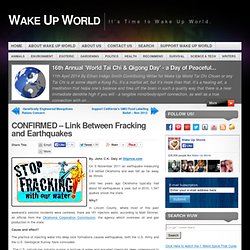
John C.K. Daly of Oilprice.com On 5 November 2011 an earthquake measuring 5.6 rattled Oklahoma and was felt as far away as Illinois. Until two years ago Oklahoma typically had about 50 earthquakes a year, but in 2010, 1,047 quakes shook the state. Why? In Lincoln County, where most of this past weekend’s seismic incidents were centered, there are 181 injection wells, according to Matt Skinner, an official from the Oklahoma Corporation Commission, the agency which oversees oil and gas production in the state. Cause and effect? The practice of injecting water into deep rock formations causes earthquakes, both the U.S. The U.S. natural gas industry pumps a mixture of water and assorted chemicals deep underground to shatter sediment layers containing natural gas, a process called hydraulic fracturing, known more informally as “fracking.”
According to the U.S. Cuadrilla Resources. Hydraulic fracturing and seismicity Last year, two earth tremors were detected following Cuadrilla’s hydraulic fracturing operations at Preese Hall. The first took place on 1st April 2011 and measured 2.3 on the Richter Scale. To determine whether this was due to hydraulic fracturing, Cuadrilla worked with Keele University and the British Geological Survey (BGS) to set optimally placed seismometers to monitor ground movements around the active well sites as well as the surrounding area.
It was during the fourth fracture treatment at Preese Hall when a second tremor measuring 1.5 was recorded on 27th May 2011. Following this and after discussions with the DECC, we voluntarily paused hydraulic fracturing operations while a report was commissioned to discover if there was a link between seismicity and fracturing. Geomechanical-Study-of-Bowland-Shale-Seismicity_02-11-11. DECC_infographic_Traffic-light-system. 5056-background-note-on-induced-seismicity-in-the-uk-an.